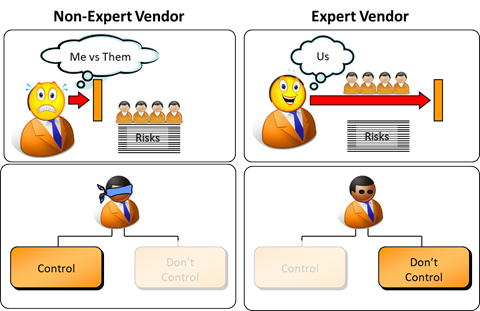
17 Dec The Secret to Mitigating Risk: Hire Experts
The following was written by Dr. Jake Gunnoe. Connect with him here.
In our last article, we talked about the true price of hiring expert vendors. It’s a common misconception to assume that expert services are more expensive. Experts only have higher prices because they offer different services compared to other vendors—bids cannot be compared like apples-to-apples. To read more about this, click here.
True experts are always cheaper than non-experts (both in terms of upfront and long-term cost).
These are the questions this article seeks to answer. Keep reading and you’ll learn:
- The root of risk
- How experts view risk
- How to save thousands by minimizing risk up front.
The truth is experts don’t have any risk — that’s why they cost less. Experts are the only people that can accurately predict project outcomes and therefore, mitigate risks before they happen.
What is Risk?
Risk is anything that causes project deviations; they are impacts to cost or schedule. There are two types of risks on projects: risks that vendors control—technical risk—and risks that vendors don’t control—non-technical risks.
Technical risks are always within a vendor’s scope. These are project-specific risks, and most of the time, only vendors can understand why they occur. Non-technical risks are outside of a vendor’s scope. They come from other stakeholders or events that aren’t directly connected to project requirements.
Expert vendors don’t cause technical risks—that is why they are experts. They are so effective at delivering their services that they can complete the job with little to no deviations. Expert vendors only focus on risks outside of their scope. They watch these risks closely so they can mitigate the impact.
Non-expert vendors only focus on risks they control. This blinds them to risks outside their scope and risks caused by stakeholders (see Figure 1). Expert vendors focus on risks they don’t control—or risks caused by other stakeholders/factors.
 Figure 1: How Different Vendors Approach Project Risks
Figure 1: How Different Vendors Approach Project Risks
This is a lot like driving a car. If you have been driving a car for many years, then you don’t need to actively focus on where you place your hands or your feet—it’s second nature. When you drive, you are more focused on other drivers or obstacles outside of your control. If you’re in the car with a driver who can’t their eyes off their own feet, then you’re in trouble.
The same is true in a project. Expert vendors deliver services as if it is second nature. The main source of risk is anything outside their scope or area of expertise. Experts are always thinking of everyone in the project. Non-experts stare at their own feet.
The Traditional Approach to Risk
There are two responses to risks: blame someone else or spend money.
Many clients try to transfer risks to vendors. They threaten canceling the contract or using litigation. In many cases, the vendors might end up paying for risks.
The other response to risk is spending more money. Either the client pays for the risks, or the vendor is forced to pay.
In reality, without knowing, the client still pays the price no matter what.
In the traditional system, all vendors know how to prepare for risk. They know that when risk occurs, they will likely suffer the financial consequences.
To account for the cost of risk, vendors will include hidden contingency costs in their price. Contingency acts as an insurance plan. Therefore, clients always pay for risk. The only way to root out contingency costs is by creating a more transparent environment.
That’s where the Best Value Approach comes in.
How the Best Value Approach Eliminates Risk
The only way to mitigate risks is by utilizing expertise. Experts are defined by their ability to preplan.
Experts understand everything within their scope of work. They can predict what will happen on a project before it happens. There are no risks within an expert’s scope because there are no unknowns.
Risks only exist outside of the expert’s scope of work. Experts mitigate risk by:
- Identifying blind spots before the project begins.
- Create a detailed plan (including budget and schedule impact) to use if unplanned events arise.
- Defining the expectations of all the stakeholders and clearly sharing them with all involved (this is creating transparency).
How to Make Sure You Hire an Expert
In the Best Value Approach (BVA), experts are the key to all project success. When clients effectively utilize and align expertise, cost goes down, performance goes up, and risk decreases drastically.
Clients can ensure they hire experts by following the BVA process.
In the BVA selection process, vendors submit a Risk Assessment (RA) in their bid. The RA allows vendors to predict any risks that might occur outside of their scope.
This has a huge benefit for the project:
- It minimizes risk and creates an upfront plan.
- It creates more transparency among stakeholders.
- This allows vendors to remove contingency costs from their bid to lower the contract price.
During the BVA clarification phase, vendors create a detailed milestone schedule and risk mitigation plan. They share this with stakeholders before the contract is signed. This eliminates the need for clients to “trust” experts. Their plan gives a clear vision of what will happen at any stage of the project.
This is the only way for clients to ensure that a vendor knows how to mitigate project-specific risks.
Throughout the project, the expert vendor tracks all deviations and any steps taken to mitigate the risk. All stakeholders will be able to track the progress of all deliverables so there are no surprises.
Conclusion
Risk is any unplanned project deviation.
Expert vendors mitigate risk by clearly identifying any potential deviations and creating an action plan to minimize negative impacts. Mitigating risks requires the ability to see into the future and plan for desired outcomes.
Experts are the best people to mitigate risk.
Many clients blame vendors for risks, but research shows that clients cause 90% of risks. When clients try to blame vendors, it leads to litigation which creates a lose-lose situation.
The Best Value Approach lessens the negative impact of risks by effectively utilizing expert vendors throughout the entire project. The BVA allows vendors to create transparency and lower costs through a risk mitigation plan.
Utilizing experts is the only effective way to mitigate risk. Clients can save up to 30% on project costs when vendors identify potential risks up front and track project deviations.
Learn More About BVA
If you would like to learn more about the Best Value Approach, here’s how you can reach us:
Sign up for the 2021 Best Value Conference
Subscribe to our YouTube Channel
Email us to set arrange a free call.


